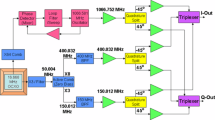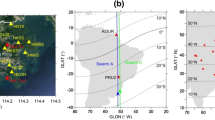Abstract
The scintillation and tomography receiver in space (CITRIS) instrument will orbit the Earth near 560 km altitude to detect signals from the ground-based array of more than 50 DORIS UHF/S-band radio beacons established at sites around the world by the French Centre National d‘Etudes Spatiales (CNES) and the Institut Géographique National (IGN). The CITRIS receiver is on the US Air Force Space Test Program satellite STPSAT1, which is scheduled for launch in November 2006. CITRIS will record ionospheric total electron content (TEC) and radio scintillations with a unique ground-to-space geometry. The new instrument has been developed to study the ionosphere using data obtained with the UHF and S-band radio transmissions from the DORIS beacons because ionospheric radio scintillations can seriously degrade the performance of many space-geodetic systems, including the DORIS precise satellite orbitography system and GNSS (Global Navigation Satellite Systems). The ionospheric data will be based on radio signals sampled at a rate of 200 Hz by the CITRIS receiver. Numerical models have been used to predict that the DORIS signals measured by CITRIS may have 30 dB fluctuations in amplitude and 30 rad in phase as the satellite flies over kilometer-scale ionospheric structures. The data from the space-based CITRIS receiver will help update and validate theories on the generation and effect of ionospheric irregularities known to influence radio systems. By using simultaneous beacon transmissions from DORIS on the ground and from low-Earth-orbit beacons in space, the concept of reciprocity in a non-bilateral propagation medium like the ionosphere will be tested. Computer simulations are used to predict the magnitude of amplitude and phase scintillations that are expected to be recorded with the CITRIS instrument.
Similar content being viewed by others
References
Aquino M, Moore T, Dodson A, Waugh S, Souter J, Rodrigues FS (2005) Implications of ionospheric scintillation for GNSS users in northern Europe. J Navig 58(2):241–256
Austen JR, Franke SJ, Liu CH (1988) Ionospheric imaging using computerized tomography. Radio Sci 23(3):299–307
Bernhardt PA, Siefring CL (2006) new satellite based systems for tomography and scintillation region imaging. Radio Sci (in press)
Bernhardt PA, Huba JD, Fulford JA, Forsyth PA, Anderson DN, Zalesak ST (1993) Analysis of rocket beacon transmissions to reconstruct ionospheric densities. Radio Sci 28:613–627
Bernhardt PA, McCoy RP, Dymond KF, Picone JM, Meier RR, Kamalabadi F, Cotton DM, Chakrabarti S, Cook TA, Vickers JS, Stephan AW, Kersely L, Pryse SE, Walker IK, Mitchell CN, Straus PR, Na H, Biswas C, Bust GS, Kronschnabl GR, Raymund TD (1998) Two-dimensional mapping of the plasma density in the upper atmosphere with computerized ionospheric tomography (CIT). Phys Plasmas 5:2010–2021
Bernhardt PA, Selcher CA, Basu S, Bust G, Reising SC (2000) Atmospheric studies with the tri-band beacon instrument on the COSMIC constellation. Terr Atmos Ocean Sci 11(1):291–312
Bernhardt PA, Selcher CA, Siefring CL, Wilkens M, Compton C, M, Fukao S, Ono T, Wakabayashi M, Mori H (2005) Radio tomographic imaging of sporadic E-layers during SEEK2. Ann Geophys 23(7):2357–2368
Bohill SA (1958) The Faraday-rotation rate of a satellite radio signal. J Atmos Terr Phys 13:175–176
Bust GS, Garner TW, Gaussiran TL (2004) Ionospheric data assimilation three-dimensional (IDA3D): global, multisensor, electron density specification algorithm. J Geophys Res 109(A11):Art. No. A11312. DOI 10.1029/2003JA010234
Candelier V, Canzian P, Lamboley J, Brunet M, Santarelli G (2003) Space qualified 5 MHz ultra stable oscillators. In: Proceedings of the 2003 IEEE international frequency control symposium & PDA exhibition jointly with the 17th European frequency and time forum,
Caton RG, McNeil WJ, Groves KM, Basu S (2004) GPS proxy model for real-time UHF satellite communications scintillation maps from the Scintillation Network Decision Aid (SCINDA). Radio Sci 39(1): Art. No. RS1S22
Davies K (1990) Ionospheric Radio. IEE Peter Peregrinus Ltd, London
de La Beaujardière O, Jeong L, Basu B, Basu Sa, Beach T, Bernhardt PA, Burke W, Groves K, Heelis R, Holzworth R, Huang C, Hunton D, Kelley M, Pfaff R, Retterer J, Rich R, Starks M, Straus P, Valladares C (2004) C/NOFS: a mission to forecast scintillations. J Atmos Solar Terr Phys 66:1573–1591
Fagard H (2006) 20 years of evolution for the DORIS network: from its initial deployment to its renovation. J Geod (this issue)
Fleury J, Roucher F, Lassudrie-Duchesne P (1991) Global TEC measurements capabilities of the DORIS system. Adv Space Res 11(10):1051–1054
Fremouw EJ, Leadabrand RL, Livingston RC, Cousins MD, Rino CL, Fair BC, Long RA (1978) Early results from the DNA wideband satellite experiment – complex signal scintillation. Radio Sci 13 (1):167–187
Garcia-Fernandez M, Saito A, Juan JM, Tsuda T (2005) Three-dimensional estimation of electron density over Japan using the GPS network combined with SAC-C data and ionosonde measurements. J Geophys Res 110(A11): Art. No. A11304 DOI 10.1029/2005JA011037
Garriott OK (1960) The determination of ionospheric electron content and distributions from satellite observations, Part 1, Theory of the analysis. J Geophys Res 65:1139–1150
Goodman JW (1968) Introduction to Fourier optics. McGraw-Hill, New York
Groves KM, Basu S, Weber EJ, Smitham M, Kuenzler H, Valladares CE, Sheehan R, MacKenzie E, Secan JA, Ning P, McNeill WJ, Moonan DW, Kendra MJ (1997) Equatorial scintillation and systems support. Radio Sci 32(5):2047–2064
Hajj GA, LJ Romans (1998) Ionospheric electron density profiles obtained with the global positioning system: results from the GPS/MET experiment. Radio Sci 33(1):175–190
Hajj GA, Wilson BD, Wang C, Pi X, Rosen IG (2004) Data assimilation of ground GPS total electron content into a physics-based ionospheric model by use of the Kalman filter. Radio Sci 39(1):RS1S05
Kelley MC (1989) The Earth’s ionosphere. Academic, San Diego
Kersley L, Klobuchar JA (1978) Comparison of protonospheric electron content measurements from the American and European Sectors. Geophys Res Lett 5(2):123–126
Kunitsyn VE, Tereshchenko ED (2003) Ionospheric tomography. Springer, Berlin Heidelberg New York
Lee L-C, Rocken C, Kursinski R (eds) (2001) Applications of constellation observing system for meteorology, ionosphere & climate. Springer, Berlin Heidelberg New York
Leitinger R, Hartmann GK, Lohmar F-J, Putz E (1984) Electron content measurements with geodetic Doppler receivers. Radio Sci 19(3):789–897
Li F, Parrot M (2006) Total electron content variations observed by a DORIS station during the 2004 Sumatra–Andaman earthquake. J Geod (this issue). DOI 10.1007/s00190-006-0053-9
Mannucci A, Wilson BD, Yuan D, Ho C, Lindqwister U, Runge T (1998) A global mapping technique for GPS-derived ionospheric total electron content measurements. Radio Sci 33(3):565–582
Na HR (guest editor) (1994) Special issue: computerized ionospheric tomography, int J Imaging Syst Technol 5(2)
Nouel F, Berthias JP, Deleuze M, Guitart A, Laudet P, Piuzzi A, Pradines D, Valorge C, Dejoie C, Susini MF, Taburiau D (1994) Precise Centre National d’Etudes Spatiales orbits for TOPEX/Poseidon – is reaching 2-cm still a challenge. J Geophys Res 99(C12):24405–24419
Ogawa T, Sinno K, Fujita M, Awaka J (1980) Severe disturbances of VHF and GHz waves from geostationary satellites during a magnetic storm. J Atmos Terr Phys 42(7):637–644
Parrot M, Li F (2004) On the TEC determination from the ionospheric DORIS products. In: IDS plenary meeting, Paris
Presser A, Camparo J (2002) Examination of a crystal oscillator’s frequency fluctuations during the enhanced space-radiation environment of a solar flare. IEEE Trans Nucl Sci 49(5):2605–2609
Pryse SE (2003) Radio tomography: a new experimental technique. Surv in Geophys 24(1):1–38
Ramo S, Whinnery JR, Van Duzer T (1965) Fields and waves in communication electronics. Wiley, New York
Saito A, Fukao S, Miyazaki S (1998) High resolution mapping of TEC perturbations with the GSI GPS network over Japan. Geophys Res Lett 25(16):3079–3082
Scherliess L, Schunk RW, Sojka JJ, Thompson DC (2004) Development of a physics-based reduced state Kalman filter for the ionosphere. Radio Sci 39(1):RS1S04
Schmidt G, Taurianen A (1975) The localization of ionospheric irregularities by the holographic method. J Geophys Res 80:4312–4324
Schreiner WS, Sokolovskiy SV, Rocken C, Hunt DC (1999) Analysis and validation of GPS/MET radio occultation data. Radio Sci 34(4):949–966
Skone S, Yousuf R, Coster A (2004) Performance of the wide area augmentation system for ionospheric storm events. J Glob Position Syst 3(1–2):251–258
Sokolovskiy S, Schreiner W, Rocken C, Hunt D (2002) Detection of high-altitude ionospheric irregularities with GPS/MET. Geophys Res Lett 29(3): Art. No. 1033
Tavernier G, Fagard H, Feissel-Vernier M, Lemoine F, Noll C, Ries J, Soudarin L, Willis P (2005) The international DORIS service. Adv Space Res 36(3):333–341
Thampi SV, Pant TK, Ravindran S, Devasia CV, Sridharan R (2004) Simulation studies on the tomographic reconstruction of the equatorial and low-latitude ionosphere in the context of the Indian tomography experiment: CRABEX. Ann Geophys 22(10):3445–3460
Trigunait A, Parrot M, Pulinets S, Li F (2004) Variations of the ionospheric electron density during the Bhuj seismic event. Ann Geophys 22(12):4123–4131
Valladares C E, Villalobos J, Sheehan R, Hagan MP (2004) Latitudinal extension of low-latitude scintillations measured with a network of GPS receivers. Annales Geophysicae 22(9):3155–3175
Wang C, Hajj G Pi X, Rosen IG, Wilson B (2004) Development of the global assimilative ionospheric model. Radio Sci 39(1):RS1S06 DOI 10.1029/2002RS002854
Ware R, Exner M, Feng D, Gorbunov M, Hardy K, Herman B, Kuo Y, Meehan T, Melbourne W, Rocken C, Schreiner W, Sokolovskiy S, Solheim F, Zou X, Anthes R, Businger S, Trenberth K (1996) GPS sounding of the atmosphere from low Earth orbit: preliminary results. Bull Am Met Soc 77:19–40
Warnant R, Morel L, Stankov S, Jodogne J-C, Nebdi H, Jakowski N (2003) The use of DORIS as a tool to study the Earth ionosphere. In: IDS analysis workshop, Marne la Vallée, 20–21 February 2003,
Willis P, Ries JC (2005) Defining a DORIS core network for Jason-1 Precise Orbit determination based on ITRF2000, methods and realizations. J Geod. 79(6–7):370–378 DOI 10.1007/s00190-005-0475-9
Willis P, Haines B, Berthias JP, Sengenes P, Le Mouel JL (2004) Behavior of the DORIS/Jason oscillator over the south atlantic anomaly. C R Geosci 336(9):839–846
Willis P, Boucher C, Fagard H, Altamimi Z (2005) Geodetic applications of the DORIS system at the French Institut Geographique National. CR Geosci 337(7):653–662 DOI 10.1016/j.crte.2005.03.002
Yeh KC, Swenson GW (1959) The scintillation of radio signals form satellites. J Geophys Res 64:2281–2286
Zalesak ST, Ossakow ST, Chaturvedi PK (1982) Non-linear equatorial spread-F – the effect of neutral winds and background Pedersen conductivity. J Geophys Res 87(NA1):151–166
Zaslavski Y, Parrot M, Blanc E (1998) Analysis of TEC measurements above active seismic regions. Phys Earth Planet Inter 105(3–4): 219–228
Zlotnicki V (1994) Correlated environmental corrections in TOPEX/ Poseidon with a note on ionospheric accuracy. J Geophys Res 99(C12):24907–24914
Author information
Authors and Affiliations
Corresponding author
Rights and permissions
About this article
Cite this article
Bernhardt, P.A., Siefring, C.L., Galysh, I.J. et al. Ionospheric applications of the scintillation and tomography receiver in space (CITRIS) mission when used with the DORIS radio beacon network. J Geodesy 80, 473–485 (2006). https://doi.org/10.1007/s00190-006-0064-6
Received:
Accepted:
Published:
Issue Date:
DOI: https://doi.org/10.1007/s00190-006-0064-6




